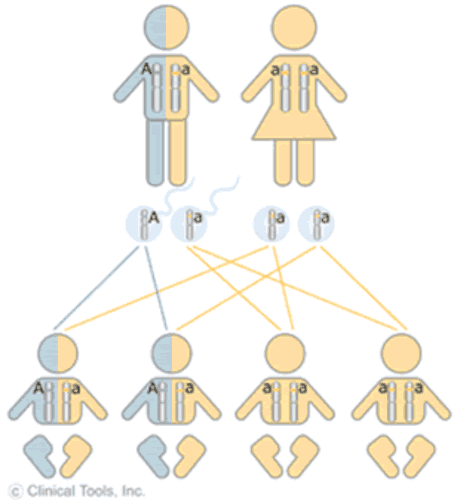Virtual Genetics Education Centre
Gene inheritance for school and colleges
Patterns of inheritance
Geneticists are interested in how genes, and the characteristics they influence, are passed on in families. We are all different, but we often look like other members of our family because we share genes in common. We may also share other characteristics with members of our family that are not so easy to spot: for example, similar patterns of health and disease.
Our physical appearance is influenced by the genes we receive from our parents
The way we look, and the way our bodies work, is affected by our genes. Each of us has two copies of every gene and two copies of every chromosome. (An exception is the sex chromosomes and the genes they contain: see DNA, genes and chromosomes.)
We get, or inherit, one copy of each gene from our mother and one copy from our father. They, in turn, received their genes from their parents. And so on back to our earliest ancestors.
The copy of a gene that we get from our father may be slightly different from the copy we get from our mother. So, for example, you might get a gene for straight hair from your father, and a gene for wavy hair from your mother. Different forms of the same gene are called alleles.
Some people have two alleles of a gene that means they can roll their tongue into a tube. (Let's call that allele 'A'.) Other people have two copies of a different allele of the same gene and can't roll their tongue. (Let's call that allele 'a'.)
Remember that we each have two copies of each gene. Imagine that a father has one A allele and one a allele (A/a). He will be able to roll his tongue, because the 'A' allele is dominant over the 'a' allele. The 'a' allele is recessive. The man's wife has two 'a' alleles (a/a), so she can't roll her tongue.

What will happen if this couple have children? An example of how some genetic traits are inherited.
The father (A/a) can pass on either an 'A' allele or an 'a' allele in his sperm. The mother (a/a) can pass on only 'a' alleles through her egg cells. On average, half of their children will be A/a, and will be able to roll their tongues. The other half will be a/a, and will not be able to roll their tongues.
Tongue rolling is an example of discontinuous variation: you either can roll your tongue or you can't. Other characteristics, for example height and weight, show continuous variation. People come in all shapes and sizes. Characteristics that show continuous variation are often the result of complex, or multifactorial, patterns of inheritance involving a number of different genes and factors in the environment (for example, diet).